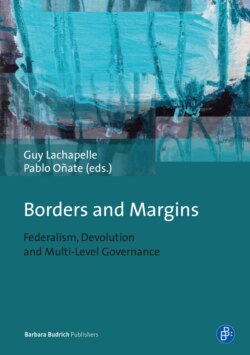Читать книгу Borders and Margins - Группа авторов - Страница 18
На сайте Литреса книга снята с продажи.
MLG versus decentralised and multinational federalism and centralised unitarism (the Westminster model) MLG versus decentralised and centralised “mature” and “emergent” federations
ОглавлениеIn an earlier paper (Stein and Turkewitsch 2008) we conducted a systematic comparison of the analytical / empirical aspects of the concepts of “federalism” and “multilevel governance” in terms of their origin, definition, evolution and the major academic criticisms directed at them. We argued that these two concepts can be viewed as mutually influencing ideas that lie on a conceptual continuum. MLG can be seen as an adaptation and extension of federalism in an age of increasingly close economic and communications globalisation. According to Marks and Hooghe (2002), these forces have tended to shift the fulcrum of the political and policy-making process vertically upwards from the nation-state level to the regional supranational or international level (e.g. in environmental and foreign trade matters). They have also tended to push this process vertically downwards to regional subnational and local levels. And they have fostered a shift outward (or horizontally) to the private or voluntary non-profit sectors (i.e. the “turn to governance”). As a result, MLG serves as a more inclusive and more applicable term for political systems having multiple tiers of autonomous decision-making than does federalism in today’s complex polycentric political decision-making world. And there has been a significant [35] degree of academic ‘cross-pollination’ between these two concepts so that “the interactive governance process that is given…a prominent place in both concepts is now regarded as a highly flexible, informal and dynamic relationship” (Stein and Turkewitsch 2008: 26).
Our subsequent contributions to this debate about the relative merits of “multilevel governance” versus “federalism” have focused specifically on the relationship between MLG and federalism as analytical tools applied comparatively to different types of federal systems outside the European Union. We compared changing patterns of intergovernmental relations in both “mature” and “emergent” parliamentary and presidential federations, and found a consistent trend, albeit to different degrees, toward the evolution and use of MLG governance patterns and networks in each. But we were unable to identify one type of federation (e.g. a parliamentary federation) as being more likely to generate these MLG patterns than another (e.g. a presidential federation). And we could not yet indicate with any precision the specific institutional, cultural and socio-economic conditions that produce and shape these MLG patterns.
